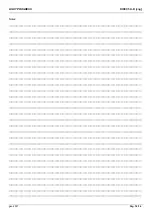
LIGHT PROGRESS
DIRECT-H-K [eng]
gen-2021
Pag. 4/16
DEVICE DESCRIPTION
The
UV-DIRECT
series includes germicidal devices using UV-C ultraviolet rays with
direct radiation
that sterilize the
air and surfaces. The UV-C lamps, with emission peak at 235.7 nm. (nanometers), have strong germicidal power
against all micro-organisms (mold, bacteria and viruses).
The
UV-DIRECT
...
K
line is destined to be recessed in the false-ceiling (or recessed in the wall) allowing finishing on
the same level, with minimal protrusions.
The shaped case consists of a box of stainless steel AISI 304with a screen in mirror-shined aluminium that increases
yield, by reflecting the part of UV-C rays that would otherwise be dispersed away from the useful direction.
The device consists of a case inside of which is enclosed a waterproof channel in aluminium containing all the electron-
ic power parts, with IP 55 degree of protection.
The UV-C lamps protected by a STAINLESS-STEEL grid. The device is supplied complete with a 3x1 mmq of 2.5 m.
cable without power plug.
OPERATION
The devices of the UV-DIRECT series can be installed in any type of environment to obtain deep disinfection of air and
surfaces, even those that are difficult to reach with traditional cleaning systems. When the lamps ON there is a strong
reduction of microbes present in the ambient air and on the surfaces reached by UV rays. For example, in 8 minutes at
a distance of 3 m. from the device, there is a 99% reduction of bacteria Bacillus, Coli, Clostridium, Legionella, Vibrio,
Salmonella, Pseudomonas, Staphylococcus, Streptococcus, etc.
Thanks to the natural circulation of the air, even the microbes located in hidden areas are continuously pulled toward
the area of the U.V. rays so that their overall level decreases progressively.
Use is allowed only with no personnel present or if contained within adequately screened areas. The device must be
switched on for 2 ± 3 hours during the hours of work breaks; for example, by means of a programming clock, night op-
eration can be managed in the hours immediately prior to the entry of the operators, to allow entry in a freshly disin-
fected site. Operation can also be managed by means of appropriate power units that, especially in case of installation
of various devices, can manage other operations, such as:
Power timing
; it is possible to regulate the duration of treatment by means of a regulatable timer.
Managing entries
; a security system turns out the lights in case of entry of staff.
Remote and local alarms
in case one or more lamps switch off, due to wear, a spy light will light up on the front panel
and it will be possible to use a contact to signal the failure remotely.
Counter
to manage the proper replacement of lamps.
BENEFITS AND ADVANTAGES
a) DEEP AND CONTINUOUS DISINFECTION
This device can be switched on continuously without people being present (i.e. during the night for 2-3 hours). The dis-
infection of the air, the machinery, and everything that is contained inside the room allows beginning the work day in
ideal hygienic conditions. In this way, the level of microbial load in one site is maintained constantly low.
b) PHYSICAL ACTION AND ECOLOGICAL PROTECTION
Treatment with UV-C rays is purely physical, always allowing treatment with the same efficiency; there is no danger of
overdosing with UV rays in the air. In contrast, many chemical treatment methods involve the use of products that are
risky and difficult to biodegrade, with consequent hazards to human health; besides, the use of chemical products, in
contrast to UV-C rays, could develop resistant microbial forms.
c) PRACTICALITY AND ECONOMY
Treatment is immediate and ready to use. Maintenance is minimal with low costs of both energy consumption and of
maintenance.
d) IMMEDIATE EFFECT
Effective treatment (99.9% bacteria reduction) takes just a few minutes.
e) NO CHEMICAL/PHYSICAL CHANGES
Treatment is cold and dry; it causes no organoleptic or qualitative changes in the food.
f) NO DANGER OF DISPERSION OF GLASS
With the special UVLON® protection, there is no danger of dispersion of glass fragments resulting from any breakage
of UV-C lamps.

































